
A few weeks ago, we had a couple of days of pretty
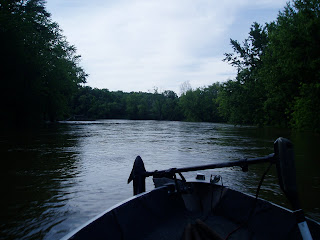
heavy rain. It had rained for 3 days in a row, so when the weather broke on Sunday, I jumped at the chance to wet a line. A friend of mine, Daryn, called me up and wondered if I was interested in heading out on the Grand River in Grand Ledge, MI to do a little bit of cat fishing.
WET LAUNCHWhen I arrived at the boat launch, it was obvious that the river was close to flood stage. The boat launch ramp was completely under water, and the current was fast
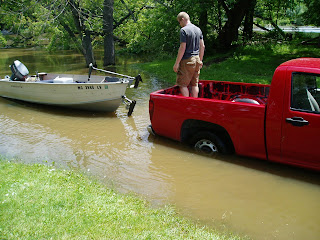
and swift. Daryn showed up shortly after I had arrived with his trusty Starcraft and we assessed the situation. We both agreed that although conditions were not exactly prime, we would FISH ON! So, Daryn hooked a snorkel up to his Colorado, put his waders on and we launched the boat. The gurgling from his exhaust, which was underwater, could only help "call in the fish" I thought. After some careful planning, we managed to bamboozle the boat in the water and we were off fishing.
TRUSTY OLE TRAIN TRESSEL
We decided to head downstream, towards the downtown area of Grand Ledge and see what the river had to offer. Our fishing strategy for river cats is to locate deep holes that are adjacent to structure such as: logjam

s, blow downs, and bridge pilings----and drift some nasty, pungent chicken liver in their faces. Normally, this is achieved by setting a float 4-6 feet deep with some split shot about a foot above our bait. However, the current was too strong for our normal tactics, so we had to improvise. Instead, we added about anywhere from 1-2 ounces of weight above our hook, and fished on the bottom. We decided to hit up the ole train tressel bridge as our first target, and Daryn had something that was playing with his bait almost immediately, but the undecided fish would not commit. I had found some soup straining "socks" that I cut into squares to wrap around my chicken liver bait, because chicken liver doesn't like to stay on the hook very well. This wrapping did not seem to be a deterrent, because I had a solid hook up on this offering, however I tied my sinkers on mighty suspect and it came back to bite me, as the fish broke the line off at the sinkers in quick fashion. I could have kicked myself for that one, but hopefully redemption would be had. After these initial signs of a hot bite, things slowed down pretty quickly, so we decided to make a move upstream.
UPSTREAM SIDE OF THINGS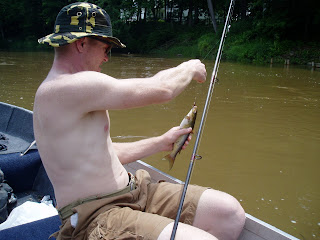
Under normal conditions, the upstream stretch of the Grand River from the J.C. Boat Launch can be extremely limiting to fish. This run of the river features a series of rocky ledges that are often less than a foot deep and have been known to crack a few hulls. Fortunately, when the river is high, navigation is quite less hairy in this stretch of river. We located the first rocky shelf, which was tucked away under nearly 5 feet of water, a good sign. We stopped in the one of the first deeper holes we came across, a 13 foot deep pool that had produced for us before. Since this part of the river holds a decent amount of carp, we decided to trade our chicken liver for some juicy night-crawlers. Not long after dropping anchor, Daryn hooked up with a channel cat and officially kicked
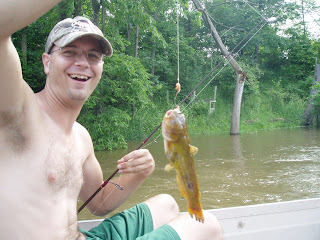
his skunking to the curb. I was starting to get nervous, because the last time I was fishing with Daryn, I ended up taking a skunking and was not eager for a repeat performance. After a while of not luck, we continued upstream in search of the next hot hole. Our next stop proved to be unproductive, so we kept moving upstream, stopping to probe various deeper pools, logjams, and slack water current seams. A few holes up the river, I finally connected with a true beast. It was all I could do to hold on as I was charged head on by a notoriously aggressive Bullhead. Under normal circumstances I would not embrace such an incidental catch, but hey it put an end to my skunking. As far as bullheads go, this one had character, scraped, bloodied and scared from his deep water tangle of a home. Later, we ended up tying off to a pile of dead-fall, and I threw my bait out along a seam in the current and into some calmer water. Moments later, my rod tip was dancing, drag was peeling and I had a legitimate fish on line. I battled the hefty fish back to the boat, and as Daryn was trying to snap an action shot boat side, the golden image of a carp surfaced from the murky water. As I reach down to land the spunky fellow, he decided to liberate himself from my line. After such a tough day on the water, both Daryn and I concurred that it would count for a catch. Our best estimation was that this carp was around 8-9 pounds, a decent fish on a slow day.
DODGING DEAD FALL AND DEER
Even though the fishing was pretty slow, there was no lack of action of this fishing excursion. On two separate occasions, we had trees drift by within feet of the boat. The f
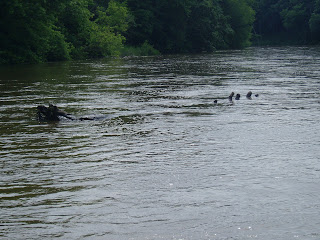
irst was at least a 30 footer, with all it's leaves and branches still intact, and would have been disastrous if it had passed inches closer to the boat. The second tree had been in or near the river for a while, only the main log was left and at twenty feet it was smaller but no less dangerous. While tied off to a pile of dead trees, a loud crash and splash alerted us. We both looked over to the opposite shore to see a sizable tree falling into the river. With the river being to high, I believe that the roots were not able to hold in the muddy, loose soil. Amongst other things, we saw the carcass of a dead deer drift by. It was almost black in color and had been ripening in or near the river for a

quite some time, as it's pleasant aroma seemed to indicate. On a more positive note, I was able to snap a photo of a doe hanging out in someone's backyard, which was surprising given the suburban nature of the area. Just before we were getting ready to call it a day, an old weather tattered life jacket came bobbing past, which we took as a sign from the fishing gods to pack it in and go get some dinner. Even with the unsavory fishing conditions, we managed to barely avoid getting skunked and had even connected with a good sized fish.
















